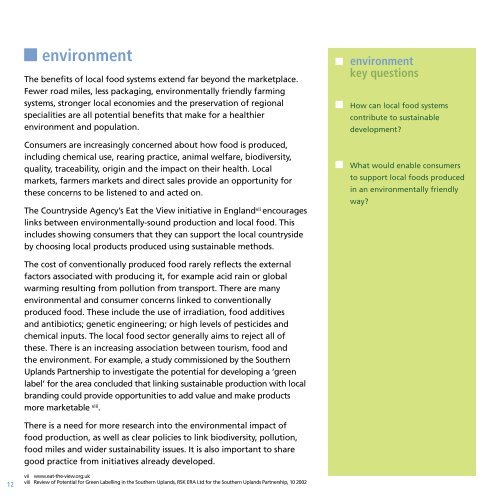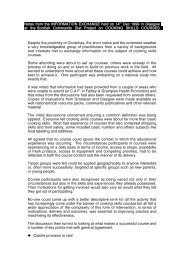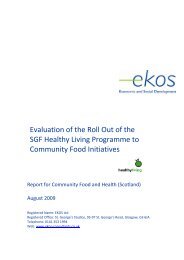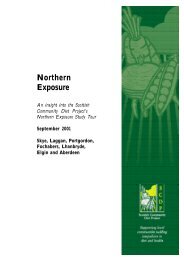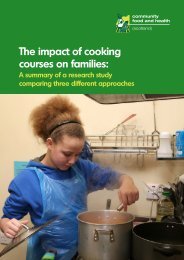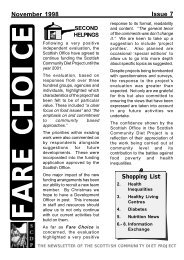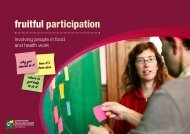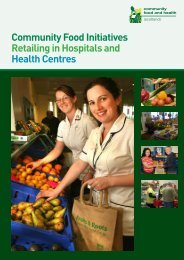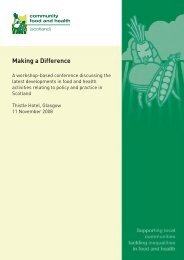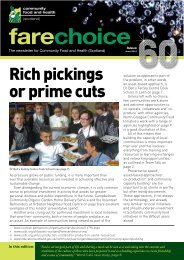Feeding the Interest - Community Food and Health
Feeding the Interest - Community Food and Health
Feeding the Interest - Community Food and Health
- No tags were found...
You also want an ePaper? Increase the reach of your titles
YUMPU automatically turns print PDFs into web optimized ePapers that Google loves.
environmentThe benefits of local food systems extend far beyond <strong>the</strong> marketplace.Fewer road miles, less packaging, environmentally friendly farmingsystems, stronger local economies <strong>and</strong> <strong>the</strong> preservation of regionalspecialities are all potential benefits that make for a healthierenvironment <strong>and</strong> population.Consumers are increasingly concerned about how food is produced,including chemical use, rearing practice, animal welfare, biodiversity,quality, traceability, origin <strong>and</strong> <strong>the</strong> impact on <strong>the</strong>ir health. Localmarkets, farmers markets <strong>and</strong> direct sales provide an opportunity for<strong>the</strong>se concerns to be listened to <strong>and</strong> acted on.The Countryside Agency’s Eat <strong>the</strong> View initiative in Engl<strong>and</strong> vii encourageslinks between environmentally-sound production <strong>and</strong> local food. Thisincludes showing consumers that <strong>the</strong>y can support <strong>the</strong> local countrysideby choosing local products produced using sustainable methods.environmentkey questionsHow can local food systemscontribute to sustainabledevelopment?What would enable consumersto support local foods producedin an environmentally friendlyway?The cost of conventionally produced food rarely reflects <strong>the</strong> externalfactors associated with producing it, for example acid rain or globalwarming resulting from pollution from transport. There are manyenvironmental <strong>and</strong> consumer concerns linked to conventionallyproduced food. These include <strong>the</strong> use of irradiation, food additives<strong>and</strong> antibiotics; genetic engineering; or high levels of pesticides <strong>and</strong>chemical inputs. The local food sector generally aims to reject all of<strong>the</strong>se. There is an increasing association between tourism, food <strong>and</strong><strong>the</strong> environment. For example, a study commissioned by <strong>the</strong> Sou<strong>the</strong>rnUpl<strong>and</strong>s Partnership to investigate <strong>the</strong> potential for developing a ‘greenlabel’ for <strong>the</strong> area concluded that linking sustainable production with localbr<strong>and</strong>ing could provide opportunities to add value <strong>and</strong> make productsmore marketable viii .There is a need for more research into <strong>the</strong> environmental impact offood production, as well as clear policies to link biodiversity, pollution,food miles <strong>and</strong> wider sustainability issues. It is also important to sharegood practice from initiatives already developed.12vii www.eat-<strong>the</strong>-view.org.ukviii Review of Potential for Green Labelling in <strong>the</strong> Sou<strong>the</strong>rn Upl<strong>and</strong>s, RSK ERA Ltd for <strong>the</strong> Sou<strong>the</strong>rn Upl<strong>and</strong>s Partnership, 10 2002


